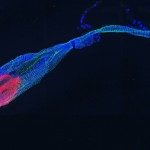Link to Pubmed [PMID] – 17560119
J. Am. Soc. Mass Spectrom. 2007 Aug;18(8):1405-13
Electron capture dissociation (ECD) has become an alternative method to collision-activated dissociation (CAD) to avoid gas-phase cleavage of post-translational modifications carried by side chains from the peptide backbone. Nonetheless, as illustrated herein by the study of O-glycosylated and O-phosphorylated peptides, the extent of ECD fragmentations may be insufficient to cover the entire peptide sequence and to localize accurately these modifications. The present work demonstrates that the derivatization of peptides at their N-terminus by a phosphonium group improves dramatically and systematically the sequence coverage deduced from the ECD spectrum for both O-glycosylated and O-phosphorylated peptides compared with their native counterparts. The exclusive presence of N-terminal fragments (c-type ions) in the ECD spectra of doubly charged molecular cations simplifies peptide sequence interpretation. Thus, the combination of ECD and fixed charge derivatization appears as an efficient analytical tool for the extensive sequencing of peptides bearing labile groups.

